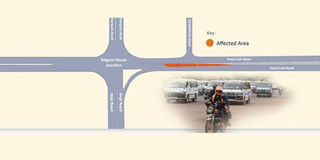Prime
How Kampala flyover works will affect traffic

Roadworks at Yusuf Lule Road commence at the weekend. PHOTO/ISMAIL KEZAALA
What you need to know:
The project, which seeks to improve the road network, is expected to cause traffic jam at the weekend.
Motorists plying the city roads should, starting this weekend, brace for interruptions in the traffic flow as construction works on the second lot of Kampala flyover starts.
Roadworks on the first lot of the project at Queensway is ongoing.
In a statement issued by Uganda National Roads Authority (Unra) on Tuesday, activities for the construction will start from Dewinton Road junction on Yusuf Lule Road.
Unra said the activities include drilling, design reviews, geotechnical studies and general preparation.
“…we expect minimal interruption in traffic flow during this exercise but traffic police will be on site for any needed traffic management. We appeal to all roadusers [pedestrians and vehicle operators] to exercise maximum caution and follow traffic guidelines around this area,” the statement read.
Unra’s manager of media relations, public and corporate affairs Allan Kyobe yesterday told Daily Monitor that the works would commence this weekend.
“There are options to manage traffic just like we did at Queensway by creating another lane, but there will be minimal traffic interruptions. We request motorists to follow guidelines that will be provided by traffic police,” Mr Kyobe said.
He said given the narrow nature of Yusuf Lule Road, creating an alternative lane may not be possible.
Traffic police had by last evening not yet issued a traffic flow plan for the affected area. However, the activities will interrupt the traffic flow on Jinja Road, the city’s busiest road, according to a 2010 World Bank study.
A slight interruption on Jinja Road affects traffic flow on other roads.
Also roads that connect to Yusuf Lule Road are likely to be affected. These include Dewinton, Nile Avenue, Centenary Park lane, Clement Hill and Shimoni roads.
For instance, motorists, who have been using Dewinton Road to exit the city, will either use Jinja Road or use the Nile Avenue and drive through the Centenary Park Lane to connect to Wampewo Avenue before joining Jinja Road.
But with Centenary Park lane being narrow and the heavy traffic flow on Yusuf Lule Road, motorists will have a rough time.
The activities will also disrupt the traffic flow on Mukwano Road, the Sixth and Seventh Street, which are already grappling with a heavy traffic gridlock following the commencement of the first lot of the flyover project at Queensway and part of Ggaba Road.
Mr Kyobe said they were in touch with traffic police to monitor the affected area, although the latter had not issued traffic guidelines by last evening.
Kampala Metropolitan traffic commander Norman Musinga did not answer our calls and neither did Mr Jacob Byamukama, the Kampala Capital City Authority’s (KCCA) deputy director roads management.
The Kampala flyover project in the Central Division seeks to undercut traffic jam and improve mobility.
The first phase of the construction project was flagged off in December 2018.
The project will be bankrolled by the Government of Japan through the Japan International Cooperation Agency at Shs224 billion. Phase two is expected to cost Shs659b.
Congestion
Study
A 2010 World pre-feasibility study for the development of a long integrated Bus Rapid Transit (BRT) system for greater Kampala Metropolitan area found out that the number of both taxis and boda bodas was increasing faster than the existing infrastructure. The study examined major transport routes within Greater Kampala and through multi-criteria appraisal made a recommendation for the further development and implementation of a Bus Rapid Transit (BRT) pilot route in the short term.
For instance, the study noted that the traffic count and occupancy for inbound routes from 6am to 10pm every day, Jinja Road was the busiest road with 9,564 taxi trips and 5,607 boda boda trips every day, followed by Entebbe Road with 9,372 taxi trips and 5177 boda boda trips
However, 10 years after the study, the number of trips for taxis and boda bodas for both inbound and outbound trips could have doubled.




